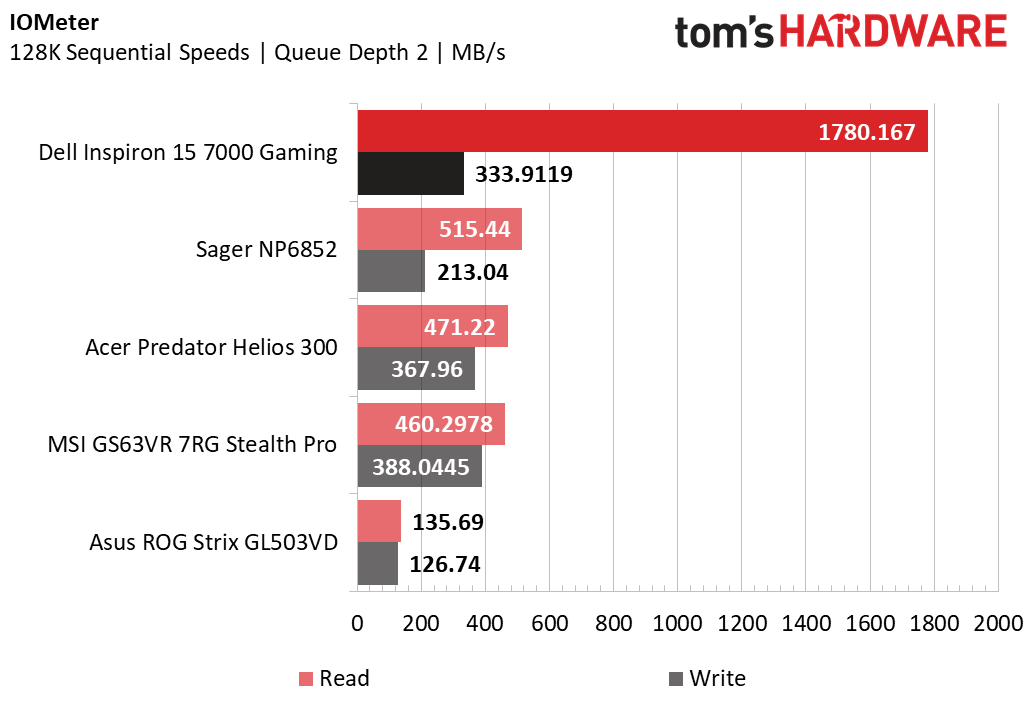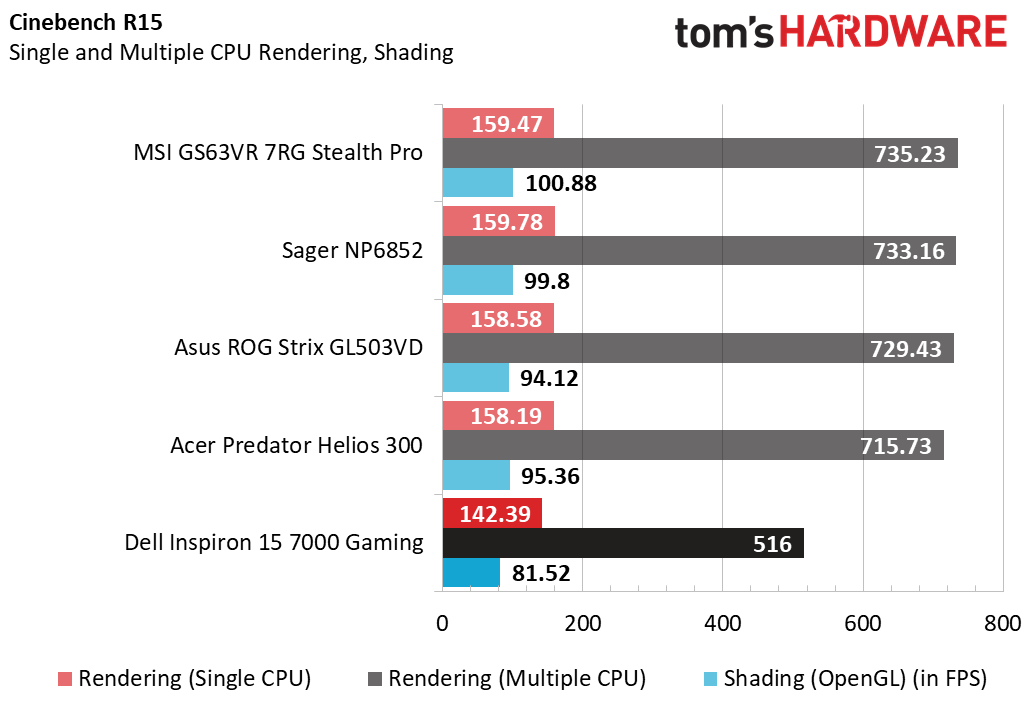Dell Inspiron 15 7000 GTX 1060 Max-Q Gaming Laptop Review
Why you can trust Tom's Hardware
Synthetic Benchmarks
The Dell Inspiron 15 7000 Gaming is the first laptop we’ve tested with a Max-Q-configured GeForce GTX 1060 GPU, so we don’t have another "perfect" laptop in our data banks to provide an apples-to-apples comparison. Still, we’ll be pitting it against systems within its price range to measure its value.
The Inspiron model we received for testing has an Intel Core i5-7300HQ, 8GB of DDR4 memory, a 256GB M.2 NVMe SSD, and a 15.6” Full HD (1920x1080) IPS display. It’s just under an inch thick and weighs 6.28 lbs, making it the thickest and heaviest laptop in our comparison set.
Now, for the competition...
We’ve pitted the Inspiron against the venerable Acer Predator Helios 300, which received our Editors' Choice award for its outstanding price-to-performance metric. The Helios features an Intel Core i7-7700HQ CPU, an "ordinary" mobile GeForce GTX 1060, 16GB of DDR4-2133 memory, a 256GB M.2 SSD, and a 15.6” FHD display. The Helios is competitively priced versus the Inspiron, so the deciding factor will be performance.
Holding the CPU constant, we have the Sager NP6852. It comes outfitted with a GeForce GTX 1050 Ti, 16GB of DDR4-2400 memory, and a 256GB M.2 SSD. The display is a 15.6” FHD matte IPS display, so the contrast should be much better than that of a TN panel. The Sager will represent the performance you can expect by stepping up (or is it down?) to a GTX 1050 Ti; we'll want to see how the GTX 1060 in Max-Q compares.
The lowest-end system in our roundup is the Asus ROG Strix GL503VD. It contains a modest-by-comparison GeForce GTX 1050 chip, but it also packs a Core i7-7700HQ and 16GB of DDR4 memory, both being more than the Inspiron has to offer. Finally, it has a 1TB SSHD (that is, a hybrid SSD and hard drive), as well as a Full HD matte IPS display, and it weighs in at 5.1 lbs. The Strix provides an interesting tradeoff between GPU and platform performance, and we’re interested to see where and how it and the Inspiron will come to blows.
Finally, the recently reviewed MSI GS63VR 7RG Stealth Pro will fulfill the high-end portion of our roundup. It contains a Core i7-7700HQ, a GeForce GTX 1070 (configured with Max-Q Design), 16GB of DDR4-2400 memory, a 256GB M.2 SSD, and a 1TB, 5400 RPM hard drive. It has a Full HD anti-glare display, but what sets it apart from the other systems is the 120Hz refresh rate. It measures 0.69” thick and weighs 3.96 lbs, making it the thinnest and lightest system in this comparison.
Get Tom's Hardware's best news and in-depth reviews, straight to your inbox.
3DMark



3DMark’s game-like workloads give us a sneak peek at our roundup’s ultimate gaming results. The Dell Inspiron 15 7000 Gaming doesn’t deliver as much graphical performance as the Acer Predator Helios 300; this is to be expected, because its Max-Q GTX 1060 runs on less power. Rather, the Inspiron delivers graphical performance between what we saw from the Helios and the Sager NP6852, which have a full-on GeForce GTX 1060 and a GeForce GTX 1050 Ti. However, the Inspiron’s i5-7300HQ doesn’t offer as much Physics performance in comparison to the machines with a Core i7-7700HQ. Luckily, this didn’t have a major effect on the overall Combined scores.
Cinebench R15
3DMark is our main graphical synthetic benchmark, whereas Cinebench measures CPU prowess, particularly the single and multi-core tests. On the other hand, the OpenGL shading test is platform-based, with a slight preference for GPU strength. We previously noted how the Inspiron’s i5 underscores the i7, and Cinebench’s CPU-bound tests illustrate this further. The Inspiron performs 11% slower and 39% slower than the Acer Helios and single core and multi-core performance respectively. The Inspiron’s OpenGL performance is negatively impacted by the i5 as well; its OpenGL frame rate is 22% lower than the Sager’s, despite the latter running a GTX 1050 Ti.
CompuBench
CompuBench offers a platform-based Video Processing test and a GPU-bound Bitcoin Mining test, which complement our 3DMark benchmarks. In CompuBench, a strong GPU can offset a low-end CPU. In Video Processing, the Inspiron outperformed the Sager and Asus ROG Strix machines by 16% and 11%, respectively. Additionally, its Max-Q GTX 1060 pulled its Bitcoin Mining score well ahead of the Sager (GTX 1050 Ti) and Asus ROG (GTX 1050). It still doesn’t hold up against the Acer Helios, however; the latter performed 27% faster.
IOMeter


We perform an IOmeter test on each laptop’s primary drive to measure basic random and sequential read and write speeds. The Dell contains a Samsung PM961 NVMe SSD. The MSI Stealth Pro features a different Samsung SSD, the 256GB Samsung PM871. The Acer Helios has a 256GB Micron 1100. The Sager NP6852 runs a 256GB SanDisk X400. Finally, the Asus ROG Strix is equipped with a hybrid hard drive, as we mentioned earlier: a 1TB Seagate FireCuda SSHD.
The Inspiron’s storage speeds provide a nice change of pace from its CPU- and GPU-bound results. Its PM961 NVMe drive delivers outstanding 4K random (QD2) results, performing the fastest in both read and write speeds. This ensures that the Inspiron can run small application-based tasks with ease. The PM961 delivers more compelling results in 128K sequential tests, especially in read speeds. If you need a system that will launch and load large files quickly, look no further than the Inspiron.
MORE: Best Gaming Laptops
MORE: Gaming Laptop Previews
MORE: All Laptop Content
Current page: Synthetic Benchmarks
Prev Page Introduction & Product Tour Next Page Gaming Benchmarks



